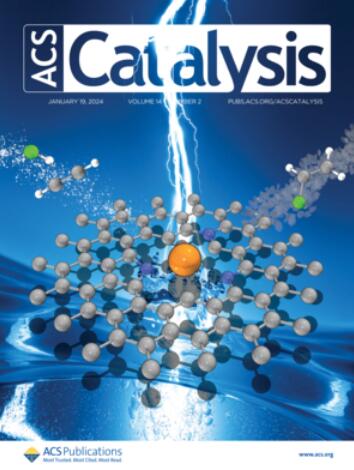Integrating Achiral Brønsted Base and Chiral Bisguanidinium for Enantioselective Phospha-Michael Addition to Chalcones
IF 11.3
1区 化学
Q1 CHEMISTRY, PHYSICAL
引用次数: 0
Abstract
The capability of classical chiral cationic phase-transfer catalyst (ccPTC) in facilitating interphase transfer of inorganic bases for asymmetric synthesis has been well recognized. However, the combination of ccPTC with achiral Brønsted bases featuring wide-ranging basicity for asymmetric organic transformation is less explored, as the racemic background reaction promoted by such organo-soluble base is generally difficult to suppress. Here, we report a highly enantioselective phospha-Michael addition reaction mediated by the neutral base 4-dimethylaminopyridine (DMAP) and ccPTC bisguanidinium (BG), wherein the chiral cationic BG snatches the ionic nucleophile phosphinothioite from the protonated DMAP via a cation exchange process. The newly formed chiral ion pair resulted in the enhancement of the reactivity of the phosphinothioite and allowed it to undergo the subsequent enantiocontrolled addition pathway. The reaction furnishes α-chiral phosphine sulfides with high synthetic utility in high yields and enantioselectivities. Detailed mechanistic studies indicated the crucial impact of confined structural features and positive charge delocalization of chiral bisguanidinium on the reaction reactivity and stereoselective outcomes.

整合非手性Brønsted碱和手性双胍对映选择性磷- michael加成至查尔酮
经典手性阳离子相转移催化剂(ccPTC)促进无机碱相间转移用于不对称合成的能力已得到广泛认可。然而,ccPTC与具有广泛碱度的非手性Brønsted碱结合用于不对称有机转化的研究较少,因为这种有机可溶性碱促进的外消旋背景反应通常难以抑制。本研究报道了一个由中性碱4-二甲氨基吡啶(DMAP)和ccPTC双胍(BG)介导的高度对映选择性磷酸-迈克尔加成反应,其中手性阳离子BG通过阳离子交换过程从质子化的DMAP中夺取离子亲核磷酸硫代石。新形成的手性离子对增强了磷硫石的反应活性,使其能够进行随后的对映控制加成途径。该反应使α-手性硫化氢具有较高的合成效率和对映选择性。详细的机理研究表明,手性双胍的限制性结构特征和正电荷离域对反应活性和立体选择结果有重要影响。
本文章由计算机程序翻译,如有差异,请以英文原文为准。
求助全文
约1分钟内获得全文
求助全文
来源期刊

ACS Catalysis
CHEMISTRY, PHYSICAL-
CiteScore
20.80
自引率
6.20%
发文量
1253
审稿时长
1.5 months
期刊介绍:
ACS Catalysis is an esteemed journal that publishes original research in the fields of heterogeneous catalysis, molecular catalysis, and biocatalysis. It offers broad coverage across diverse areas such as life sciences, organometallics and synthesis, photochemistry and electrochemistry, drug discovery and synthesis, materials science, environmental protection, polymer discovery and synthesis, and energy and fuels.
The scope of the journal is to showcase innovative work in various aspects of catalysis. This includes new reactions and novel synthetic approaches utilizing known catalysts, the discovery or modification of new catalysts, elucidation of catalytic mechanisms through cutting-edge investigations, practical enhancements of existing processes, as well as conceptual advances in the field. Contributions to ACS Catalysis can encompass both experimental and theoretical research focused on catalytic molecules, macromolecules, and materials that exhibit catalytic turnover.
 求助内容:
求助内容: 应助结果提醒方式:
应助结果提醒方式:


